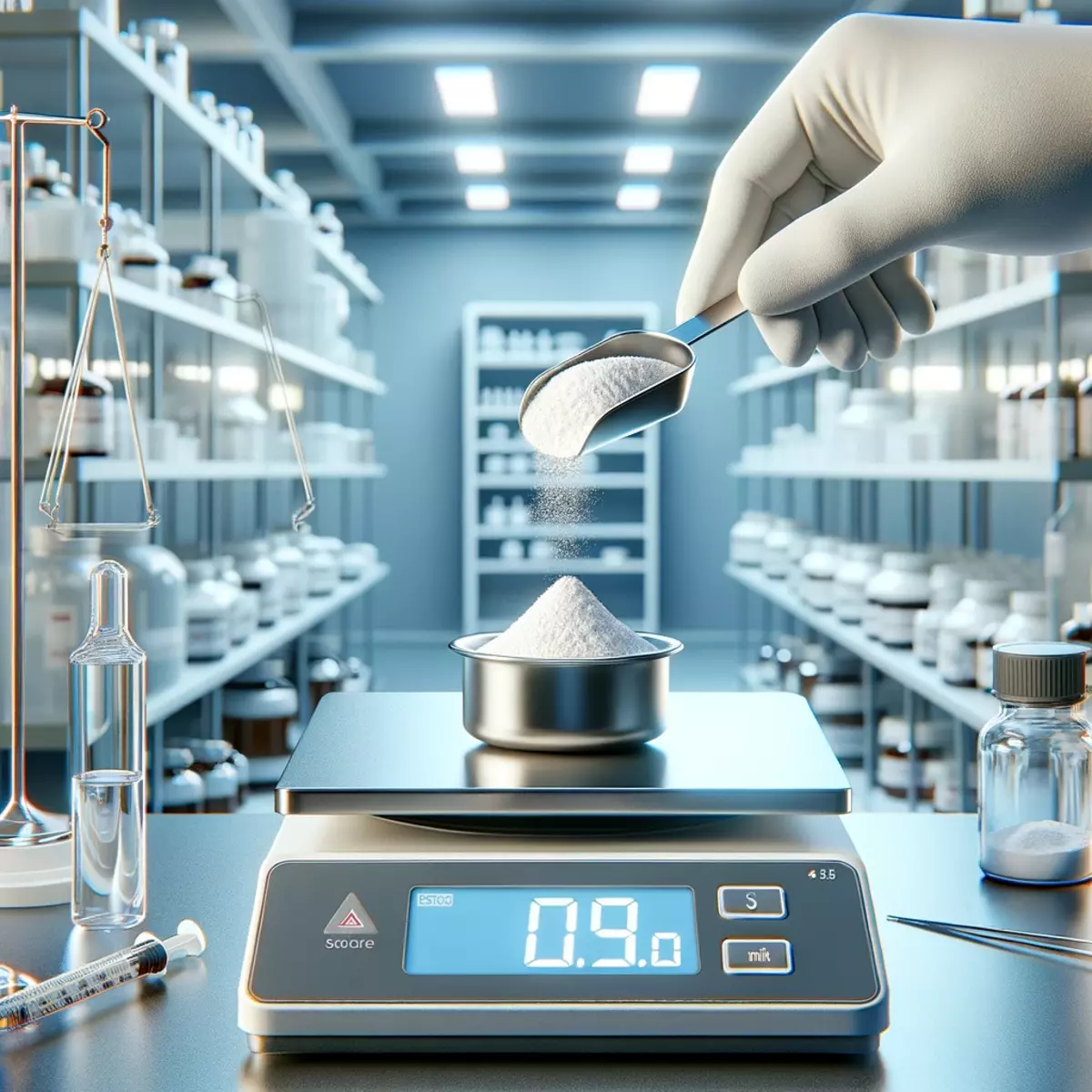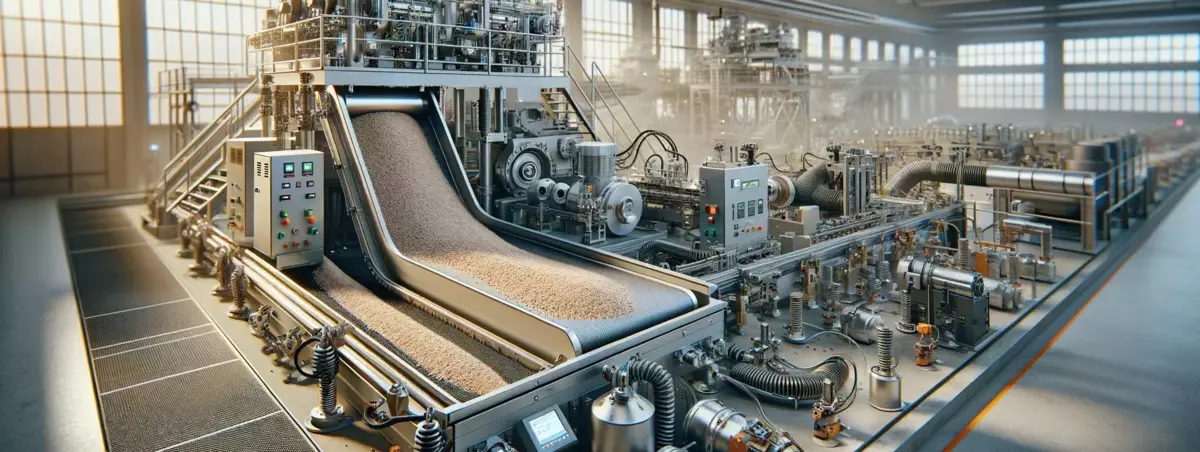Powder feeders - a comprehensive guide
The precise feeding of powders is essential in industrial processes to ensure efficiency, safety and product quality. This complex operation requires a deep understanding of the physical and chemical properties of powders as well as the specific requirements of production processes. Choosing the right dosing system is crucial and depends on many factors, including the type of powder, dosing accuracy and throughput rates. Technologies such as screw conveyors, vibratory feeders and pneumatic systems offer different advantages and disadvantages that need to be carefully weighed up.
On this page we provide comprehensive information on dosing methods, optimization techniques and safety aspects. We present case studies of successful implementations and discuss future trends that can further improve efficiency and precision. Our goal is to create a centralized information portal to help you find the best dispensing solution for your needs, optimize processes and ultimately achieve your production goals. Discover with us the basics, technologies and innovations in the field of powder dosing in industrial applications.
Feeding powder: Feeders, controllers and control units from a single source.
Contact
DEMIC Datentechnik GmbH
Ohlenhohnstraße 48
53819 Neunkirchen
Phone: +49 2247 918 90
E-Mail: kontakt(at)demic-datentechnik.de
Principles of powder feeding
Feeding powders in industrial applications is a critical step that requires precision and understanding of materials and processes. Powders can be challenging due to their diverse properties such as particle size, flow behavior and moisture absorption. These properties influence the choice of dosing method and technology.
Feeding powders in industrial processes is largely determined by the physical and chemical properties of the powders. Particle size and distribution are critical for powder feeders, as fine powders tend to agglomerate and therefore present challenges for uniform powder dosing, while coarse-grained powders have better flowability but can be prone to bridging or clogging. Flowability, another critical factor, affects how easily powder can flow out of a container; poorly flowing powders often require special dosing systems to avoid blockages and ensure consistent feeding. Hygroscopic powders, which absorb moisture from the surrounding air, can clump or agglomerate, affecting the dosing accuracy of powder feeders and requiring special attention during storage and handling. Understanding these characteristics is critical to the selection and design of effective dosing systems to ensure accurate and efficient dosing. Manufacturers must carefully consider these variables to minimize powder dosing errors, ensure product quality and optimize the production process.
Powder feeders: feeding methods and technologies
Feeding methods and technologies play a central role in precise and efficient handling by powder feeders in industrial processes. They include a wide range of systems tailored to the specific properties of the material and the requirements of the production line. From screw conveyors and vibratory feeders, which are characterized by their ability to ensure a consistent supply of material, to weigh feeders and pneumatic systems for high-precision applications, each powder feeder offers unique benefits. Proper selection and customization of these technologies is critical to maximizing feeding accuracy and achieving production goals.

Screw feeder (Auger)
Screw feeder, also known as augers, are a widely used category of powder feeders in industrial processes. They consist of a spiral screw in a tube that transports the material from the filling point to the outlet. Their strength lies in their precision and reliability, especially when feeding dry, free-flowing powders. Powder feeders as screw conveyors enable controlled material feed and are available in various sizes and configurations to meet specific requirements. They are particularly suitable for applications that require accurate dosing and can be easily integrated into automated systems. Their simple design also facilitates maintenance and cleaning.
Vibration feeder
Vibrating feeders, as a category of powder feeders, use vibration mechanisms to convey and dispense powders and granular materials evenly. By applying vibratory energy to the material container, these powder feeders promote a controlled, uniform flow of material to the dispensing point. This category is particularly well suited for difficult flowing, sticky or fine powders that are prone to bridging or agglomeration, as the vibration helps overcome these challenges. Vibratory feeders offer high flexibility in terms of flow rate adjustability and are known for their precision and ability to handle materials gently. Their adaptability makes them a preferred choice for various industrial applications.
Dosing scales
As powder feeders, dosing scales are precise instruments for measuring the weight of powders and granular materials in industrial dosing processes. They work on the principle of gravimetric feeding, where the material is fed directly onto the scale and the weight is recorded continuously or in batches to ensure high accuracy of feeding. Dosing scales are ideal for applications where exact quantities and high repeatability are required. With their ability to provide real-time feedback on dispensed weight, this category of powder feeders enables precise control of the dispensing process, resulting in improved product quality and process efficiency. They are available in various sizes and configurations to meet different production requirements.
Pneumatic systems
Pneumatic conveying systems use compressed air or negative pressure to transport and dispense powders and granular materials through closed piping systems. This method is ideal for the gentle and clean handling of materials over short to medium distances. Pneumatic systems minimize the risk of product contamination and exposure to the environment, making them particularly attractive for applications in the food, pharmaceutical and chemical industries. Thanks to their flexible pipe routing, they can be easily integrated into complex systems. They also offer advantages in terms of safety and hygiene, as they are closed systems and reduce the risk of dust formation and material loss.
Choosing the right feeding system
Choosing the right dosing system is crucial for the efficiency and quality of industrial production processes. It requires careful consideration of the material characteristics, process requirements and environmental conditions. Different systems such as screw conveyors, vibratory feeders, weigh feeders and pneumatic conveying systems offer specific advantages for different applications. The ideal solution maximizes dosing accuracy, minimizes product loss and optimizes handling efficiency. Factors such as particle size, powder flow characteristics, dosing speed and volume, hygiene requirements and ability to integrate into existing production lines must be considered when making a selection to ensure seamless and cost-effective production.
Material specification
The selection of a feeding system begins with a thorough analysis of the material specification, as the physical and chemical properties of the powder to be fed are critical to the performance and efficiency of the system. Particle size and distribution affect the flow characteristics of the powder; fine powders can tend to agglomerate, while coarser materials flow better but can lead to clogging. Flowability is another critical factor that determines how easily the material can be moved through the dispensing system. Materials with poor flowability may require special conveying techniques or equipment to ensure a consistent feed.
Hygroscopic powders, which absorb moisture from the environment, can form lumps and require dosing systems that can prevent or break such lumps. In addition, the chemical compatibility between the material and the components of the dosing system must be taken into account in order to avoid corrosion or chemical reactions. Knowing the material specification makes it possible to select a dosing system that preserves the integrity of the powder, maximizes dosing accuracy and ensures product quality.
Process requirements
Considering the process requirements is a critical step in selecting the right dosing system. This includes determining the required dosing accuracy, throughput volume, operating conditions and integration into existing production processes. High dosing accuracy is particularly important in the pharmaceutical and food industries, where precision has a direct impact on the quality and safety of the end product. The throughput volume, i.e. the amount of material that needs to be dosed per unit of time, determines the size and performance of the required system.
Operating conditions also play a role, including ambient temperature, humidity and the need to avoid cross-contamination. Systems often need to be integrated into existing production lines, which means that they must be compatible with other machines and fit into the overall process. Automation levels, ease of use and maintenance requirements also need to be considered. A system that meets these requirements not only improves efficiency and productivity, but also working conditions and safety in the workplace. Careful analysis of the process requirements ensures the selection of a dosing system that is optimally suited to the specific needs of production.
Environmental conditions
The environmental conditions within the production facility are crucial for selecting the right dosing system. Factors such as dust generation, humidity, temperature fluctuations and potential explosion hazards from flammable powders must be carefully evaluated. Systems used in dusty or humid environments require appropriate protective measures to ensure reliable operation and increase safety. Moisture, for example, can impair the flow properties of powders and lead to lump formation, which reduces dosing accuracy. Dosing systems with integrated drying functions or those that are insensitive to moisture are therefore preferable in such environments.
In areas with high or low temperatures, the materials of the dosing systems must be selected accordingly in order to avoid thermal expansion or material embrittlement. When handling flammable powders, the prevention of sparking and static build-up by the dispensing system is of paramount importance to minimize explosion risks. Systems designed for such conditions often include grounding, inerting and explosion protection measures. Taking these environmental conditions into account ensures that the selected dosing system not only works effectively and efficiently, but also ensures the safety of the operation and employees.
Powder feeder: Optimization and maintenance
The optimization and maintenance of dosing systems is crucial to maintaining their efficiency, accuracy and longevity. Regular maintenance, including cleaning and checking for wear parts, ensures that the systems run smoothly and dosing accuracy is guaranteed. Calibration of dosing equipment is also important to obtain precise measurements and ensure product quality. Optimization measures can include adjusting dosing parameters, updating software or retrofitting with more advanced components to improve performance. Proactive maintenance and continuous optimization help to minimize downtime, increase production efficiency and reduce operating costs.
Powder feeder: Safety considerations
When feeding powders, safety considerations must be a top priority in order to minimize risks to employees and production facilities. Dust generation can cause respiratory illnesses and create explosive atmospheres, especially with fine or organic powders. To minimize these risks, closed systems, dust extraction and regular cleaning are essential. It is also important to ground dispensing equipment to prevent static discharges. When handling chemically reactive or toxic powders, appropriate protective measures such as protective clothing and suitable ventilation systems are essential. Safety guidelines and regulations must always be adhered to in order to ensure safe operation.
Powder feeder: Use in laboratory
In laboratories, the use of powder feeders plays a crucial role in achieving precise and reproducible results in the research and development of new products. In the laboratory, powder feeders are often used to dispense precise amounts of chemicals, pharmaceuticals or other powdered materials for experiments, quality control and analytical testing. The ability to ensure accurate and repeatable dosing is particularly important in the laboratory environment as it forms the basis for reliable experimentation and analysis.
Modern laboratory powder feeders are often equipped with advanced technology that enables high precision. They can be programmed to automatically dispense the required amount of powder with minimal deviation, increasing efficiency in the laboratory and reducing the likelihood of human error. In addition, they enable fast and clean handling of powders, increasing laboratory safety and minimizing the risk of contamination.
In laboratories where working conditions can vary greatly, powder dispensers are often designed to be flexible and customizable. This allows laboratory professionals to use them for a wide range of applications, from research to quality control. The integration of powder feeders in laboratories therefore contributes significantly to increasing accuracy, efficiency and safety in the handling of powders.
Your contact
Björn Demmer
Shareholder - General manager
PHONE: +49 2247 918 90
E-MAIL: bdemmer(at)demic-datentechnik.de
Heinz Demmer
Shareholder - General manager
PHONE: +49 2247 918 90
E-MAIL: hdemmer(at)demic-datentechnik.de



